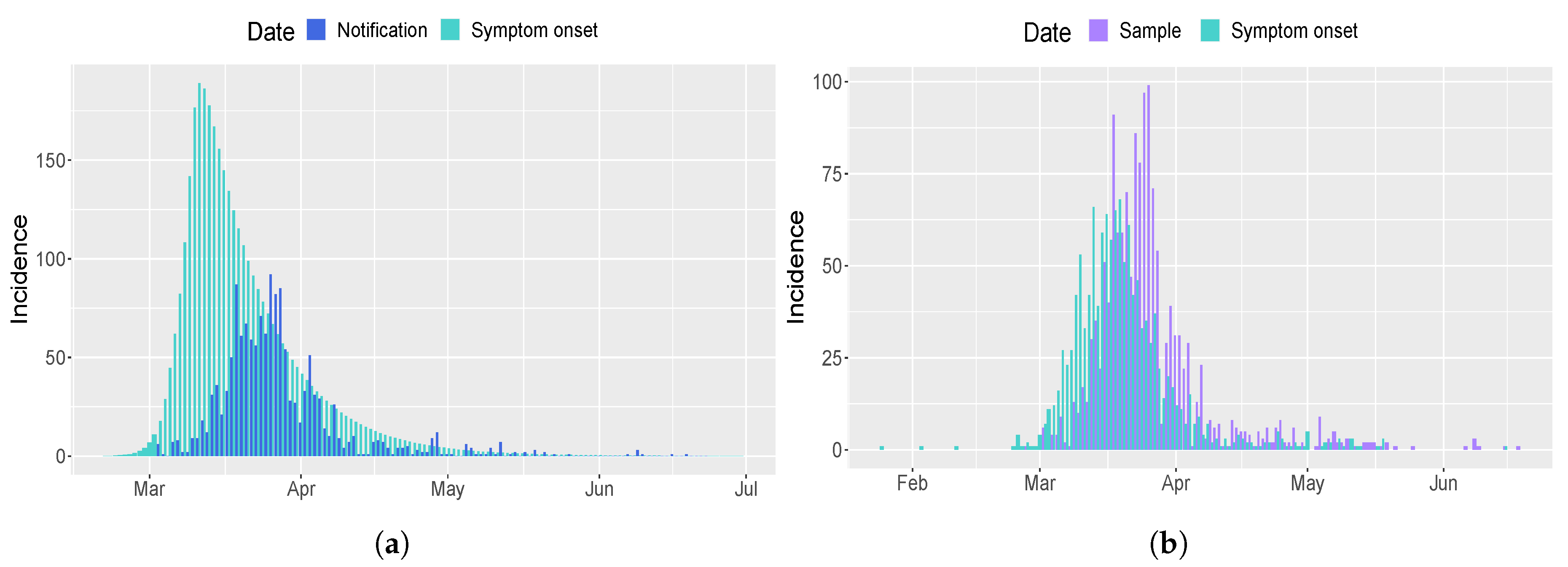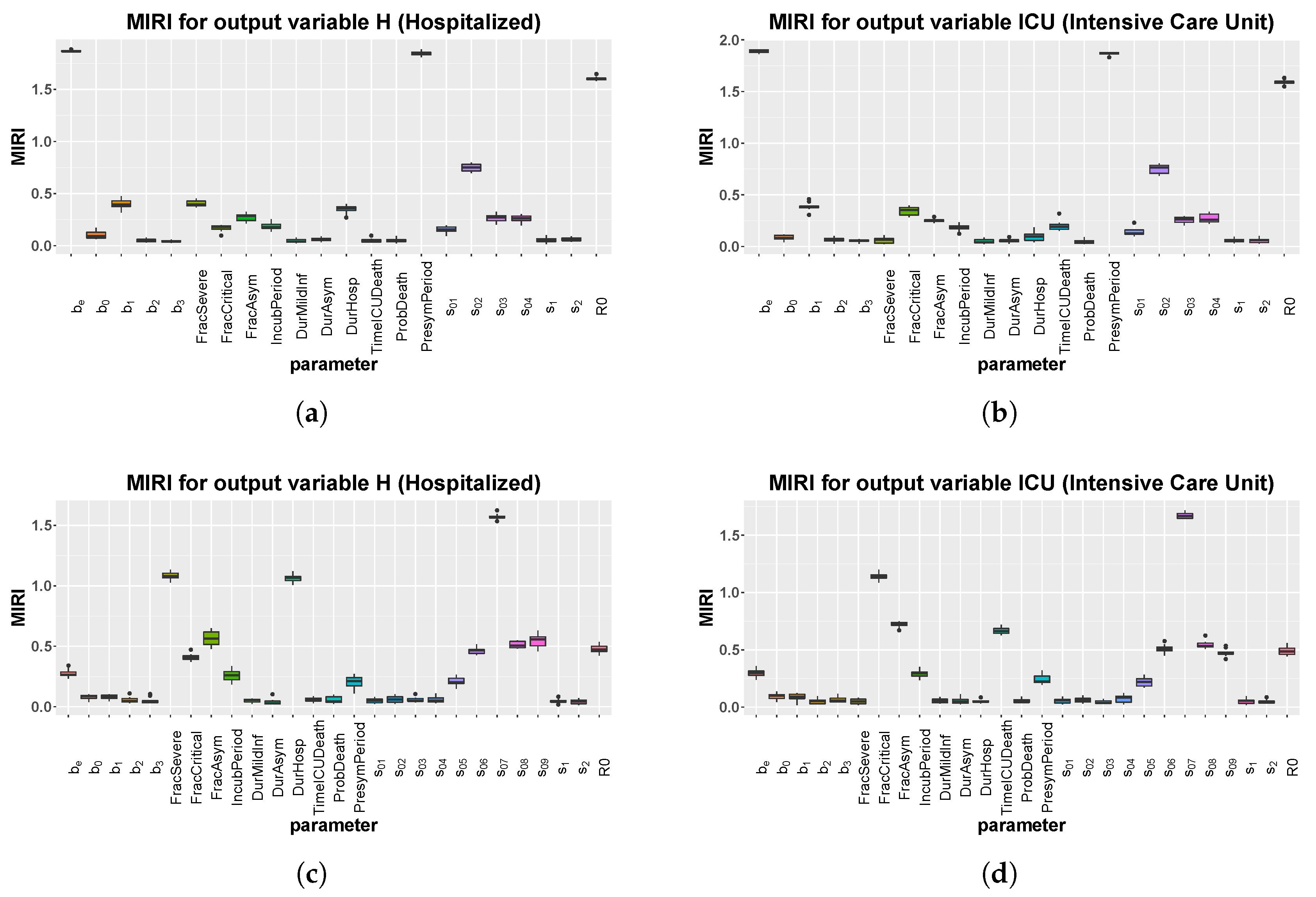Mathematical Modeling and Robustness Analysis to Unravel COVID-19 Transmission Dynamics: The Italy Case †
Simple Summary
Abstract
1. Introduction
2. Methods
2.1. Mathematical Model
- S: susceptible individuals,
- E: exposed individuals,
- : presymptomatic individuals,
- A: asymptomatic individuals,
- M: people with mild infection,
- H: people with severe infection which requires hospitalization,
- : people with critical infection which requires ICU level care,
- R: individuals who have recovered from the disease, and
- D: dead people.
- (1)
- (2)
- (3)
- (4)
- (5)
- (6)
- (7)
- (8)
- (9)
- (10)
- ,
- the average number of secondary infections generated from an individual in class ,
- the fraction of people that progresses to class A multiplied by the average number of secondary infections that are generated from an infected person in stage A,
- the fraction of people that progresses to class M multiplied by the average number of secondary infections generated from an infected person in stage M,
- the probability that an infected individual progresses to class H multiplied by the average number of secondary infections generated from a patient in stage H, and
- the probability that an infected individual progresses to class multiplied by the average number of secondary infections generated from a patient in stage .
2.2. Data
2.3. Model Calibration Using CRC
2.4. Conditional Robustness Analysis
3. Results
3.1. CRC Results: Italy Case
- (1)
- 21 February 2020 (), creation of two quarantined red areas under strict lock-down in Lombardy and Veneto;
- (2)
- 24 February 2020 (), school closure in most regions in the Northern of Italy (Lombardy, Veneto, Emilia-Romagna, Friuli Venezia Giulia, Liguria, Piedmont and part of Marche);
- (3)
- 5 March 2020 (), school closure in the entire country;
- (4)
- 8 March 2020 (), total lock-down area in the Northern of Italy; and,
- (5)
- 10 March 2020, total lock-down area extended to all Italian regions.
- from day 0 until , from to , from to , from to and from onward;
- from day 0 until , from to , from to , from to and from onward;
- from day 0 until then from onward;
- from day 0 until then from onward; and,
- from day 0 until then from onward.
- the number of samples in the parameter space is set to for each iteration;
- to perturb the parameter space, we use Linear and Logarithmic LHS according to the prior distributions shown in Table 1;
- the number of iterations is equal to 8; and,
- the number of realizations performed is set to 10, to ensure reliability of results.
3.2. CRC Results: Umbria Case
- from day 0 until , from to and then from onward;
- from day 0 until , from to , from onward;
- from day 0 until then from onward;
- from day 0 until then from onward; and,
- from day 0 until then from onward.
3.3. CRA Results: Italy Case
3.4. CRA Results: Umbria Case
4. Discussion
5. Conclusions
Supplementary Materials
Author Contributions
Funding
Acknowledgments
Conflicts of Interest
References
- World Health Organization. Coronavirus Disease 2019 (COVID-19); Situation Report 51; World Health Organization: Geneva, Switzerland, 2020. [Google Scholar]
- Dati Della Sorveglianza Integrata COVID-19 in Italia. 2020. Available online: https://www.epicentro.iss.it/coronavirus/sars-cov-2-dashboard (accessed on 20 September 2020).
- Wang, Y.; Wang, Y.; Chen, Y.; Qin, Q. Unique epidemiological and clinical features of the emerging 2019 novel coronavirus pneumonia (COVID-19) implicate special control measures. J. Med Virol. 2020, 92, 568–576. [Google Scholar] [CrossRef] [PubMed]
- Gatto, M.; Bertuzzo, E.; Mari, L.; Miccoli, S.; Carraro, L.; Casagrandi, R.; Rinaldo, A. Spread and dynamics of the COVID-19 epidemic in Italy: Effects of emergency containment measures. Proc. Natl. Acad. Sci. USA 2020, 117, 10484–10491. [Google Scholar] [CrossRef] [PubMed]
- Giordano, G.; Blanchini, F.; Bruno, R.; Colaneri, P.; Di Filippo, A.; Di Matteo, A.; Colaneri, M. Modelling the COVID-19 epidemic and implementation of population-wide interventions in Italy. Nat. Med. 2020, 26, 855–860. [Google Scholar] [CrossRef] [PubMed]
- Calafiore, G.C.; Novara, C.; Possieri, C. A modified sir model for the covid-19 contagion in italy. arXiv 2020, arXiv:2003.14391. [Google Scholar]
- Casella, F. Can the COVID-19 epidemic be controlled on the basis of daily test reports? IEEE Control Syst. Lett. 2020, 5, 1079–1084. [Google Scholar] [CrossRef]
- Della Rossa, F.; Salzano, D.; Di Meglio, A.; De Lellis, F.; Coraggio, M.; Calabrese, C.; Guarino, A.; Cardona, R.; DeLellis, P.; Liuzza, D.; et al. Intermittent yet coordinated regional strategies can alleviate the COVID-19 epidemic: A network model of the Italian case. arXiv 2020, arXiv:2005.07594. [Google Scholar]
- Antonini, C.; Calandrini, S.; Stracci, F.; Dario, C.; Bianconi, F. Dynamical modeling, calibration and robustness analysis of COVID-19 using Italian data. In Proceedings of the 20th International Conference on Bioinformatics and Bioengineering, BIBE, Virtual Conference, USA, 26–28 October 2020. in press. [Google Scholar]
- Modeling COVID-19 Spread vs. Healthcare Capacity. 2020. Available online: https://alhill.shinyapps.io/COVID19seir/ (accessed on 10 July 2020).
- Nande, A.; Adlam, B.; Sheen, J.; Levy, M.Z.; Hill, A.L. Dynamics of COVID-19 under social distancing measures are driven by transmission network structure. medRxiv 2020. [Google Scholar] [CrossRef]
- Bianconi, F.; Antonini, C.; Tomassoni, L.; Valigi, P. Robust calibration of high dimension nonlinear dynamical models for omics data: An application in cancer systems biology. IEEE Trans. Control Syst. Technol. 2018, 28, 196–207. [Google Scholar] [CrossRef]
- Bianconi, F.; Antonini, C.; Tomassoni, L.; Valigi, P. Application of conditional robust calibration to ordinary differential equations models in computational systems biology: A comparison of two sampling strategies. IET Syst. Biol. 2020, 14, 107–119. [Google Scholar] [CrossRef] [PubMed]
- Bianconi, F.; Tomassoni, L.; Antonini, C.; Valigi, P. A New Bayesian Methodology for Nonlinear Model Calibration in Computational Systems Biology. Front. Appl. Math. Stat. 2020, 6, 25. [Google Scholar] [CrossRef]
- Bianconi, F.; Baldelli, E.; Luovini, V.; Petricoin, E.F.; Crino, L.; Valigi, P. Conditional robustness analysis for fragility discovery and target identification in biochemical networks and in cancer systems biology. BMC Syst. Biol. 2015, 9, 70. [Google Scholar] [CrossRef] [PubMed]
- Bianconi, F.; Antonini, C.; Tomassoni, L.; Valigi, P. CRA toolbox: Software package for conditional robustness analysis of cancer systems biology models in MATLAB. BMC Bioinform. 2019, 20, 385. [Google Scholar] [CrossRef] [PubMed]
- Tönsing, C.; Timmer, J.; Kreutz, C. Profile likelihood-based analyses of infectious disease models. Stat. Methods Med. Res. 2018, 27, 1979–1998. [Google Scholar] [CrossRef] [PubMed]
- López, L.; Rodo, X. A Modified SEIR Model to Predict the COVID-19 Outbreak in Spain and Italy: Simulating Control Scenarios and Multi-Scale Epidemics. 2020. Available online: https://ssrn.com/abstract=3576802 (accessed on 20 September 2020).
- Fosu, G.O.; Akweittey, E.; Adu-Sackey, A. Next-Generation Matrices and Basic Reproductive Numbers for All Phases of the Coronavirus Disease. Open J. Math. Sci. 2020, 4, 261–272. [Google Scholar] [CrossRef]
- Stella, L.; Martínez, A.P.; Bauso, D.; Colaneri, P. The Role of Asymptomatic Individuals in the COVID-19 Pandemic via Complex Networks. arXiv 2020, arXiv:2009.03649. [Google Scholar]
- Dipartimento Protezione Civile, GitHub Repository. 2020. Available online: https://github.com/pcm-dpc/COVID-19 (accessed on 10 July 2020).
- Vollmer, M.; Mishra, S.; Unwin, H.; Gandy, A.; Melan, T.; Bradley, V.; Zhu, H.; Coupland, H.; Hawryluk, I.; Hutchinson, M.; et al. Report 20: A Sub-National Analysis of the Rate of Transmission of Covid-19 in Italy; Medical Research Council: London, UK, 2020. [Google Scholar]
- Impatto Dell’epidemia COVID-19 Sulla Mortalità Totale Della Popolazione Residente Nel Periodo Gennaio-Maggio 2020. Available online: https://www.istat.it/archivio/covid-19 (accessed on 20 September 2020).
- Istituto Superiore di Sanità, Sistema di Sorveglianza Integrata COVID-19. 2020. Available online: https://www.epicentro.iss.it/coronavirus/sars-cov-2-sorveglianza (accessed on 20 September 2020).
- Nishiura, H.; Kobayashi, T.; Miyama, T.; Suzuki, A.; Jung, S.M.; Hayashi, K.; Kinoshita, R.; Yang, Y.; Yuan, B.; Akhmetzhanov, A.R.; et al. Estimation of the asymptomatic ratio of novel coronavirus infections (COVID-19). Int. J. Infect. Dis. 2020, 94, 154. [Google Scholar] [CrossRef] [PubMed]
- Epidemiologia Regione Umbria. 2020. Available online: https://www.epicovid19umbria.org/epi_umbria.html (accessed on 30 September 2020).
- Scala, A.; Flori, A.; Spelta, A.; Brugnoli, E.; Cinelli, M.; Quattrociocchi, W.; Pammolli, F. Time, space and social interactions: Exit mechanisms for the COVID-19 epidemics. arXiv 2020, arXiv:2004.04608. [Google Scholar] [CrossRef] [PubMed]
- Armocida, B.; Formenti, B.; Ussai, S.; Palestra, F.; Missoni, E. The Italian health system and the COVID-19 challenge. Lancet Public Health 2020, 5, e253. [Google Scholar] [CrossRef]








| Parameter | Prior | Italy | Umbria |
|---|---|---|---|
| log-U(0.001,3) | 0.98 | 1.2633 | |
| log-U(0.001,3) | 0.0292 | 0.0115 | |
| log-U(0.001,3) | 0.0585 | 0.0052 | |
| log-U(0.001,3) | 0.0249 | 0.0045 | |
| log-U(0.001,3) | 0.0066 | 0.0169 | |
| FracSevere | log-U(0.01,0.4) | 0.1066 | 0.1131 |
| FracCritical | log-U(0.01,0.3) | 0.0944 | 0.1308 |
| FracAsym | U(0.1,0.6) | 0.3127 | 0.2916 |
| IncubPeriod | U(4,14) | 5.7009 | 5.4046 |
| DurMildInf | U(2,80) | 9.2534 | 9.9375 |
| DurAsym | U(2,30) | 19.8963 | 10.4581 |
| DurHosp | U(2,90) | 16.2593 | 12.0868 |
| TimeICUDeath | U(2,70) | 4.8568 | 5.7772 |
| ProbDeath | U(1,90) | 88.6568 | 27.0937 |
| PresymPeriod | log-U(0.5,0.9) | 0.7243 | 0.7248 |
| log-U(0.5,0.9) | 0.5922 | 0.5732 | |
| log-U(0.4,0.9) | 0.5035 | 0.0955 | |
| log-U(0.3,0.7) | 0.3982 | - | |
| log-U(0.05,0.5) | 0.1031 | - | |
| log-U(0.1,0.9) | 0.1452 | 0.2360 | |
| log-U(0.1,0.9) | 0.1842 | 0.2481 |
Publisher’s Note: MDPI stays neutral with regard to jurisdictional claims in published maps and institutional affiliations. |
© 2020 by the authors. Licensee MDPI, Basel, Switzerland. This article is an open access article distributed under the terms and conditions of the Creative Commons Attribution (CC BY) license (http://creativecommons.org/licenses/by/4.0/).
Share and Cite
Antonini, C.; Calandrini, S.; Stracci, F.; Dario, C.; Bianconi, F. Mathematical Modeling and Robustness Analysis to Unravel COVID-19 Transmission Dynamics: The Italy Case. Biology 2020, 9, 394. https://doi.org/10.3390/biology9110394
Antonini C, Calandrini S, Stracci F, Dario C, Bianconi F. Mathematical Modeling and Robustness Analysis to Unravel COVID-19 Transmission Dynamics: The Italy Case. Biology. 2020; 9(11):394. https://doi.org/10.3390/biology9110394
Chicago/Turabian StyleAntonini, Chiara, Sara Calandrini, Fabrizio Stracci, Claudio Dario, and Fortunato Bianconi. 2020. "Mathematical Modeling and Robustness Analysis to Unravel COVID-19 Transmission Dynamics: The Italy Case" Biology 9, no. 11: 394. https://doi.org/10.3390/biology9110394
APA StyleAntonini, C., Calandrini, S., Stracci, F., Dario, C., & Bianconi, F. (2020). Mathematical Modeling and Robustness Analysis to Unravel COVID-19 Transmission Dynamics: The Italy Case. Biology, 9(11), 394. https://doi.org/10.3390/biology9110394





